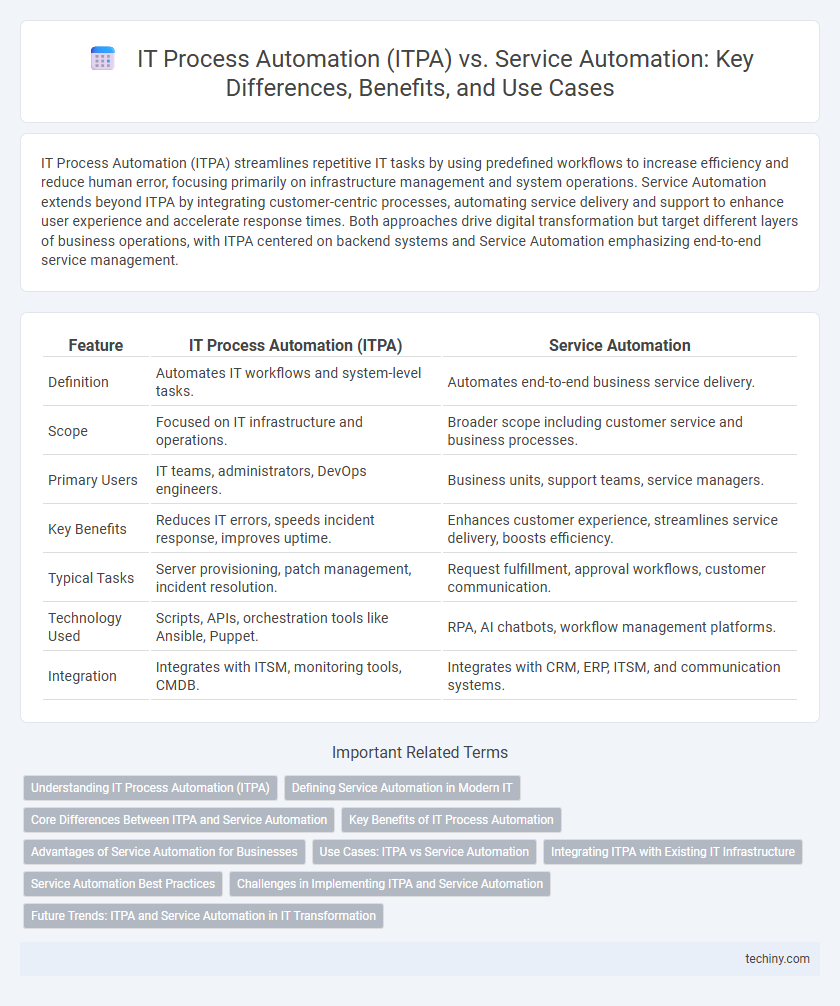IT Process Automation (ITPA) streamlines repetitive IT tasks by using predefined workflows to increase efficiency and reduce human error, focusing primarily on infrastructure management and system operations. Service Automation extends beyond ITPA by integrating customer-centric processes, automating service delivery and support to enhance user experience and accelerate response times. Both approaches drive digital transformation but target different layers of business operations, with ITPA centered on backend systems and Service Automation emphasizing end-to-end service management.
Table of Comparison
| Feature | IT Process Automation (ITPA) | Service Automation |
|---|---|---|
| Definition | Automates IT workflows and system-level tasks. | Automates end-to-end business service delivery. |
| Scope | Focused on IT infrastructure and operations. | Broader scope including customer service and business processes. |
| Primary Users | IT teams, administrators, DevOps engineers. | Business units, support teams, service managers. |
| Key Benefits | Reduces IT errors, speeds incident response, improves uptime. | Enhances customer experience, streamlines service delivery, boosts efficiency. |
| Typical Tasks | Server provisioning, patch management, incident resolution. | Request fulfillment, approval workflows, customer communication. |
| Technology Used | Scripts, APIs, orchestration tools like Ansible, Puppet. | RPA, AI chatbots, workflow management platforms. |
| Integration | Integrates with ITSM, monitoring tools, CMDB. | Integrates with CRM, ERP, ITSM, and communication systems. |
Understanding IT Process Automation (ITPA)
IT Process Automation (ITPA) focuses on automating routine IT tasks and workflows such as server provisioning, software deployment, and incident response to improve efficiency and reduce human error. It leverages tools like orchestration platforms and robotic process automation (RPA) specifically designed for IT environments to streamline complex operations. Unlike broader Service Automation, which targets end-to-end service delivery across various business functions, ITPA concentrates on optimizing IT-specific processes within the infrastructure and application management domains.
Defining Service Automation in Modern IT
Service Automation in modern IT streamlines repetitive and complex service tasks by leveraging advanced technologies such as AI, machine learning, and orchestration tools to improve efficiency and reduce human error. Unlike IT Process Automation (ITPA), which focuses on automating specific IT workflows or processes, Service Automation encompasses end-to-end service management, including incident resolution, service request fulfillment, and customer interactions. This holistic approach enhances service delivery, optimizes resource allocation, and accelerates digital transformation initiatives within IT operations.
Core Differences Between ITPA and Service Automation
IT Process Automation (ITPA) focuses on automating complex IT workflows such as system monitoring, incident management, and software deployment, emphasizing backend infrastructure efficiency. Service Automation, by contrast, streamlines customer-focused service delivery processes like ticketing, self-service portals, and user request management, enhancing end-user experience. The core difference lies in ITPA targeting internal IT operations for operational agility, while Service Automation prioritizes customer interaction and service management optimization.
Key Benefits of IT Process Automation
IT Process Automation (ITPA) enhances operational efficiency by automating repetitive IT tasks, reducing human error and accelerating incident resolution. It improves system reliability and compliance through standardized workflows and real-time monitoring. ITPA also enables scalable IT service delivery, freeing up resources for strategic initiatives and innovation.
Advantages of Service Automation for Businesses
Service Automation enhances customer experience through real-time support and faster resolution times, reducing operational costs by minimizing manual interventions. It streamlines workflows across departments, improving service consistency and compliance with regulatory standards. Businesses benefit from increased scalability and agility, enabling rapid adaptation to changing market demands and customer needs.
Use Cases: ITPA vs Service Automation
IT Process Automation (ITPA) targets repetitive, rule-based IT tasks such as system monitoring, incident management, and software deployment, improving efficiency and reducing human error. Service Automation encompasses broader customer-facing processes like ticketing, service requests, and workflows across IT and business units. ITPA excels in backend infrastructure operations, while Service Automation enhances overall service delivery and user experience by integrating multi-channel support and self-service capabilities.
Integrating ITPA with Existing IT Infrastructure
Integrating IT Process Automation (ITPA) with existing IT infrastructure enhances operational efficiency by automating routine workflows across servers, networks, and applications without disrupting current systems. ITPA leverages APIs and connectors to seamlessly interact with legacy platforms, enabling real-time data synchronization and reducing manual intervention. This integration supports proactive incident response and consistent service delivery, distinguishing it from broader service automation focused on end-user interactions.
Service Automation Best Practices
Service Automation best practices emphasize aligning automated workflows with user experience to enhance service delivery efficiency and accuracy. Implementing standardized service catalogues and continuous monitoring ensures consistent service quality and rapid incident resolution. Integrating AI-driven analytics further optimizes service automation by predicting issues and personalizing responses.
Challenges in Implementing ITPA and Service Automation
Implementing IT Process Automation (ITPA) involves challenges such as integrating diverse legacy systems, ensuring data accuracy across automated workflows, and maintaining compliance with security protocols. Service Automation faces obstacles including aligning automation with complex customer service processes, managing change resistance among staff, and delivering consistent end-user experiences. Both require robust governance frameworks and continuous monitoring to optimize performance and mitigate operational risks.
Future Trends: ITPA and Service Automation in IT Transformation
Future trends in IT Process Automation (ITPA) and Service Automation highlight increased integration of AI-driven workflows to enhance predictive analytics and self-healing capabilities, accelerating IT transformation. ITPA focuses on automating complex backend processes such as incident resolution and change management, while Service Automation streamlines user-facing tasks like service requests and approvals. Both technologies converge to create a seamless IT ecosystem that improves operational efficiency, reduces human error, and drives faster digital innovation.
IT Process Automation (ITPA) vs Service Automation Infographic

 techiny.com
techiny.com